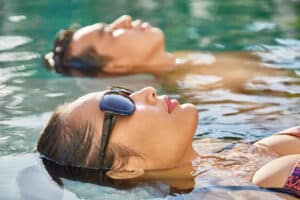Did you know that 1 in 10 children have wax build-up issues?
If you enjoy spending time in the water or catching some waves at one of Australia’s many spectacular beaches, we have some tips to look after and maintain your ear health.
Unfortunately, one of the biggest downsides of spending time in the water is the effect it can have on your ears.

Does water become trapped inside of your ear canal?
Water becoming trapped inside of the ear or feeling ‘water-logged’ is an issue that can present itself from being in the water.
This has the potential to lead to ‘swimmer’s ear’, also known as otitis externa; an infection or inflammation of the outer ear canal. This condition can cause many debilitating symptoms, some of which include-
- Pain
- Itching
- Muffled Hearing
- Pressure or fullness inside of the ear
What are Exostoses or Surfer’s Ear?
Surfer’s ear or Exostoses, is a slowly progressing benign bone growth from exposure to cold water exposure. This can lead to ear wax impaction, ear infections and hearing loss.
How can I protect my ears in and out of the water?
1. Use swimming ear plugs
Swimming ear plugs can help to keep the ears dry and prevent water from entering the ear canal. This may reduce the likelihood of developing exostoses/surfer’s ear and can also help to reduce the risk of swimmer’s ear. However, regular ear plugs usage can prevent the natural ear cleaning process by blocking the exit for wax and debris and pushing wax deeper into the ear canal, causing the earwax to build up. This generally occurs for people who use ear plugs for long periods of time of time. Swimming ear plugs are usually only worn for short periods of time and can be helpful for people who are prone to getting water trapped behind wax build up.
2. Do not use cotton buds or ear cleaning devices
Putting cotton buds or anything into the ear canal can push wax further into the ear and has the potential to cause harm to your delicate canal walls or ear drum.
Wax that is stuck inside of the ear canal can expand when water is trapped inside of the ear which may result in symptoms of an ear wax blockage.
3. Use over the counter drops to help prevent ‘swimmer’s ear
If water becomes stuck inside of your ear, there are products that are available at your local pharmacy to help. You cannot use these drops if you have a hole in the ear drum or grommets. Speak to your health professional about whether these drops are suitable for you.
4. Use a hair dryer on low heat
If you feel like there is water trapped inside of your ears, you can use a hair dryer on low heat to help dry the ears.
5. If you feel like you have an ear wax blockage, use ear wax softening drops
Ear wax softening drops can help soften and break down wax and can create a ‘gap’ which may allow for symptom relief. Please consult a healthcare professional about whether drops are suitable for you. Please do not use drops if you have a hole in your ear drum or grommets.
6. Get your ears cleaned at Earworx
Water can cause ear wax in your ear canals to expand and block your ears. Ear wax build-up also increases the likelihood that water will become trapped in your ears, as the earwax forms a barrier that prevents the water from exiting the ear canal.
Have your ears checked and cleaned by the earwax removal professionals at Earworx.
Earworx is a dedicated ear wax removal service using the dry, gentle and safe technique ‘microsuction’ which is the preferred method used by ENT specialists. It is performed by our highly trained Registered Nurses who will educate you on ear health and help to reduce your discomfort.
To book an appointment, please call 1800 327 967 or book online at www.earworx.com.au




